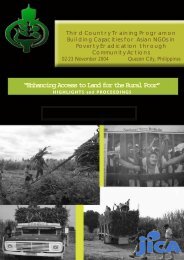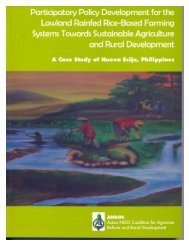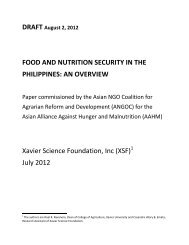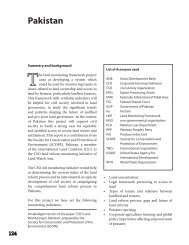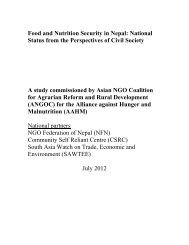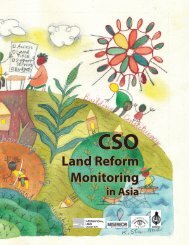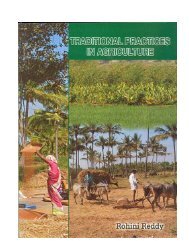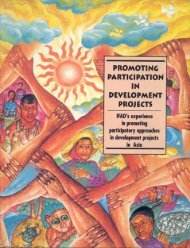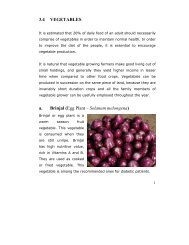Securing the Right to Land FULL - ANGOC
Securing the Right to Land FULL - ANGOC
Securing the Right to Land FULL - ANGOC
You also want an ePaper? Increase the reach of your titles
YUMPU automatically turns print PDFs into web optimized ePapers that Google loves.
By December 1970, about a million hectares of ceiling surplus<br />
agricultural land had reverted <strong>to</strong> <strong>the</strong> States for redistribution <strong>to</strong><br />
<strong>the</strong> landless. Fifty per cent of this land was redistributed <strong>to</strong> <strong>the</strong><br />
rural poor—but not necessarily <strong>to</strong> <strong>the</strong> landless—because most if<br />
not all of <strong>the</strong> land ceiling laws failed <strong>to</strong> provide clear eligibility<br />
criteria for recipients of surplus land.<br />
From 1965 <strong>to</strong> 1969, India faced a severe food crisis, widespread<br />
agrarian unrest, armed movements by communist groups resulting<br />
in <strong>the</strong> killing of landlords and land-grabbing, as well as a<br />
split in <strong>the</strong> ruling Congress Party. The Ministry of Home Affairs<br />
categorically stated that <strong>the</strong> failure of land reform measures<br />
was directly responsible for <strong>the</strong> widespread agrarian unrest. This<br />
led <strong>to</strong> <strong>the</strong> third phase—comprehensive land reforms—which included<br />
lowering of <strong>the</strong> land ceilings and restrictions on exemptions<br />
from <strong>the</strong> land ceiling laws.<br />
PHASE 3: Comprehensive <strong>Land</strong> Reform Program<br />
(1971–1985)<br />
A conference of <strong>the</strong> chief ministers of States in New Delhi on<br />
23 July 1972, marked <strong>the</strong> beginning of <strong>the</strong> third phase of<br />
India’s land reform venture. At this conference, <strong>the</strong> Government<br />
managed <strong>to</strong> push a proposal for a comprehensive land reform<br />
program, which included a lowering of land ceilings. A<br />
ceiling of four <strong>to</strong> seven hectares was imposed on governmentirrigated<br />
land; and five <strong>to</strong> seven hectares, on privately irrigated<br />
land. However, <strong>the</strong> ceiling on o<strong>the</strong>r kinds of agricultural land<br />
was higher.<br />
The new land ceiling law provided that landless agricultural laborers,<br />
particularly those belonging <strong>to</strong> Scheduled Castes (SCs) and<br />
Scheduled Tribes (STs), would be prioritized in <strong>the</strong> redistribution of<br />
ceiling surplus land. The States were directed <strong>to</strong> amend <strong>the</strong>ir respective<br />
laws in accordance with <strong>the</strong> new land ceiling law by 31<br />
December 1972. Yet, in spite of <strong>the</strong> directive <strong>to</strong> <strong>the</strong> States and<br />
<strong>the</strong> implementation of a 20-Point National Program (during <strong>the</strong><br />
National Emergency), which also included land reforms <strong>to</strong> be enforced<br />
in letter and spirit, no significant headway was made in<br />
<strong>the</strong> implementation of <strong>the</strong> land ceiling laws. According <strong>to</strong> data<br />
compiled by <strong>the</strong> Ministry of Agriculture, by <strong>the</strong> middle of 1986,<br />
only 1,850,447 hectares of land had been declared ceiling surplus;<br />
of this, 1,312,536 hectares had reverted <strong>to</strong> <strong>the</strong> States, and<br />
only 922,529 hectares had been redistributed. Hence, <strong>the</strong> new<br />
land ceiling laws had yielded few improvements compared <strong>to</strong> <strong>the</strong><br />
old ones: a 58% increase in ceiling surplus land; a 27% increase<br />
in land that reverted <strong>to</strong> <strong>the</strong> States; and a 10% increase in land<br />
RIDING THE CREST OF PEOPLE’S MOVEMENTS<br />
79<br />
redistributed <strong>to</strong> <strong>the</strong> landless. However, <strong>the</strong> Eleventh Plan (2007–<br />
12) document shows that 2.1 million hectares of 2.98 million<br />
hectares of ceiling surplus land have been redistributed so far.<br />
PHASE 4: <strong>Land</strong> Development Program (1985–1995)<br />
This phase was characterized by increased attention <strong>to</strong> land development<br />
programs. Soil and water conservation measures<br />
were implemented through <strong>the</strong> Drought Prone Areas Program<br />
(DPAP), <strong>the</strong> Desert Development Program (DDP), and wastelands<br />
development initiatives. A massive program was undertaken for<br />
watershed development by establishing a Watershed Development<br />
Authority.<br />
PHASE 5: Impact of Liberalization Policy and<br />
Mainstreaming of <strong>Land</strong> Reform Agenda (1995 onwards)<br />
Due <strong>to</strong> <strong>the</strong> liberalization policy adopted by <strong>the</strong> Government, <strong>the</strong><br />
relevance of a number of land laws has become <strong>the</strong> subject of<br />
debate, and proposals for <strong>the</strong> computerization of land records<br />
have been put forward. <strong>Land</strong> policies are being reviewed in <strong>the</strong><br />
light of issues related <strong>to</strong> land fragmentation, among o<strong>the</strong>rs, and<br />
<strong>the</strong> wisdom of opening up <strong>the</strong> tenancy market.<br />
During <strong>the</strong> fifth phase, India has seen an increase in caste and<br />
class violence. The Naxalite movement in Bihar was fed by <strong>the</strong><br />
age-old exploitation of agricultural laborers and by <strong>the</strong> latter’s<br />
resentment and <strong>the</strong> apathy of <strong>the</strong> authorities. Left-leaning parties<br />
and o<strong>the</strong>r major political parties in <strong>the</strong> State believe that<br />
land reforms are <strong>the</strong> key <strong>to</strong> checking extremism in Bihar. Therefore,<br />
in 2006 <strong>the</strong> Bihar government appointed a <strong>Land</strong> Reforms<br />
Commission headed by D. Bandyopadhyay. In its report submitted<br />
recently (2008) <strong>to</strong> <strong>the</strong> government of Bihar, <strong>the</strong> Commission<br />
recommended sweeping land reforms such as providing<br />
legal safeguards <strong>to</strong> bataidars (sharecroppers), improving <strong>the</strong> revenue<br />
administration, identifying and taking over ceiling surplus<br />
land still illegally held by landlords, and addressing <strong>the</strong> discrepancies<br />
in contract farming. In addition, it recommended:<br />
abolition of <strong>the</strong> distinction between agricultural and nonagricultural<br />
land;<br />
doing away with <strong>the</strong> general exemption given <strong>to</strong> plantations,<br />
fisheries, etc;<br />
a ceiling of 15 acres per family as well as per religious establishment<br />
and per sugar mill;<br />
acceptance of 9 July 1949 as <strong>the</strong> cut-off date, absentee<br />
landlords <strong>to</strong> be given <strong>the</strong> option of personal cultivation or<br />
through government;<br />
and <strong>the</strong> allotment of between one acre and 0.66 acre of<br />
ASIAN NGO COALITION FOR AGRARIAN REFORM AND RURAL DEVELOPMENT



